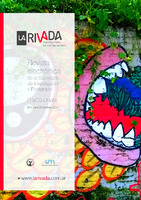Simios, humanos, (re)evolución. Los textos de la cultura y la irresoluble frontera entre lo humano y lo animal
Apes / humans / (re)evolution. Texts of culture and the irresolvable boundary between human and animal
| dc.rights.license | Licencia de Creative Commons Reconocimiento-NoComercial-CompartirIgual 4.0 Internacional (CC BY-NC-SA 4.0) | |
| dc.contributor.illustrator | Tejeda Cajas, Facundo | |
| dc.creator | Gómez Ponce, Ariel | |
| dc.date.accessioned | 2017-09-15T20:25:33Z | |
| dc.date.accessioned | 2019-08-21T22:38:30Z | |
| dc.date.available | 2017-09-15T20:25:33Z | |
| dc.date.available | 2019-08-21T22:38:30Z | |
| dc.date.issued | 2015-12-01 | |
| dc.identifier.citation | Gómez Ponce, A. (2015). Simios, humanos, (re)evolución. Los textos de la cultura y la irresoluble frontera entre lo humano y lo animal. La Rivada, investigaciones en ciencias sociales. Posadas (Misiones): UNaM. FHyCS; 2(5), 1-12. | |
| dc.identifier.issn | 2347-1085 | |
| dc.identifier.other | RLR-048 | |
| dc.identifier.uri | https://hdl.handle.net/20.500.12219/1824 | |
| dc.identifier.uri | http://www.larivada.com.ar/index.php/ediciones-anteriores/65-numero-5-diciembre-2015/articulos-5/103-simios-humanos-evolucion | |
| dc.description | Fil: Gómez Ponce, Ariel. Universidad Nacional de Córdoba. Secretaría de Ciencia y Tecnología; Argentina. | es_AR |
| dc.description.abstract | Los teóricos nos indican que, desde hace algunos años, el lugar del animal no-humano es reevaluado y las ciencias vienen a cuestionar un antropocentrismo que erosiona las fronteras en apariencia bien definidas con el mundo natural. Desde que nos separamos de los restantes primates, hace casi 7 millones de años, preguntarnos acerca de las similitudes y diferencias con el animal implica no sólo un reconocimiento de nuestro vínculo con las restantes especies sino, además, de nuestra propia humanidad. Estos interrogantes implican un modo de apropiación compleja del mundo del afuera mediante un “quiebre de fronteras”: en términos lotmanianos, nos referimos a una traducción, mecanismo mediante el cual la cultura se autodefine y determina, asimismo, a las figuras que expulsa de su sistema un Otro (tanto cultural como natural). En clave ecosemiótica, nos interesamos aquí por observar cómo la cultura traduce nuestra relación con este Otro natural, entendiendo que el primate no-humano se presenta como figura privilegiada dado que instaura formas de (des) articulación de los dominios naturales y culturales que discuten la propia ontogenia humana. En su circulación textual, simios y monos reinscriben territorios y movilizan marcos de significación de la condición humana, actualizándose como “traductores naturales” que problematizan lo humano, lo inhumano y lo no-humano. Al abordar ciertas textualidades provenientes del orden artístico, científico y de la vida cotidiana, atenderemos a la figura del primate que, como categoría que se desplaza culturalmente, se presenta como mecanismo buffer que estructura una zona de indeterminación: un “umbral crítico” en el cual la diferencia entre lo humano y lo animal se somete a discusión. | es_AR |
| dc.description.abstract | Scholars tell us that, for some years, the place of the non human animal is reevaluated and science is trying to question an anthropocentrism which erodes a, in appearance, well-defined borders with the natural world. Since we separated from the other primates almost, 7 million years ago, questioning about the similarities and differences with the animal involves not only the recognition of our relationship with the other species but also our own humanity. These questions involve a way of complex appropriation of the world outside through a “break of boundaries”: in Iuri Lotman’s terms, we refer to a translation mechanism by which culture defines itself and also determined the figures expelled from their system (a cultural and a natural Other). In ecosemiotic key, we are interested in observe how culture translates our relationship with this natural Other, understanding that the nonhuman primate appears as privileged figure which establish forms of (dis)articulation between natural and cultural domains and discuss the own human ontogeny. In its textual circulation, apes and monkeys reinscribed territories and mobilize frameworks of signification of the human condition, updating as nonhuman “natural translators” which problematise human and inhuman condition. In approaching certain textualities from the artistic, scientific and everyday order, we will attend to the figure of the primate which, as category that moves culturally, is presented as a mechanism that structures a buffer zone of indeterminacy: a “critical threshold” where the difference between human and animal is subjected to discussion. | en |
| dc.format | application/pdf | |
| dc.language.iso | spa | es_AR |
| dc.publisher | Universidad Nacional de Misiones. Facultad de Humanidades y Ciencias Sociales. Secretaría de Investigación y Posgrado | es_AR |
| dc.rights.uri | http://creativecommons.org/licenses/by-nc-sa/4.0/ | |
| dc.source | La Rivada, investigaciones en ciencias sociales (Misiones), 12-2015; 2(5): pp. 1-12 http://www.larivada.com.ar/ | |
| dc.subject | Simios | es_AR |
| dc.subject | Humanos | es_AR |
| dc.subject | Textos | es_AR |
| dc.subject | Cultura | es_AR |
| dc.subject | Frontera | es_AR |
| dc.subject | Apes | en |
| dc.subject | Humans | en |
| dc.subject | Texts | en |
| dc.subject | Culture | en |
| dc.subject | Boundary | en |
| dc.title | Simios, humanos, (re)evolución. Los textos de la cultura y la irresoluble frontera entre lo humano y lo animal | es_AR |
| dc.title | Apes / humans / (re)evolution. Texts of culture and the irresolvable boundary between human and animal | en |
| dc.type | info:eu-repo/semantics/article | |
| dc.type | info:ar-repo/semantics/artículo | |
| dc.type | info:eu-repo/semantics/publishedVersion |
Files in this item
This item appears in the following Collection(s)
-
Revista La Rivada [229]
En esta colección se depositan los artículos publicados en la Revista digital La Rivada, una publicación semestral de la SINVyP-FHyCS-UNaM.




